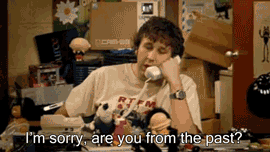Phone Numbers Are Stuck In The Dark Ages. Why?
Remember the days of desktop email clients? Me neither. It was what feels like a nano-second in time, before the emergence of Hotmail, Yahoo Mail, the now all-powerful GMail and the multitude of other webmail solutions available today.

The original idea of a desktop email client like Outlook or Thunderbird made sense when the majority of us only used one computer. At that point it didn’t matter if your email was trapped inside that one machine. Where else were you going to go to access it anyway?
Today pretty much no one uses only one device. Maybe our grandparents? Mobility is the name of the game, so even “PopPop” probably has an iPad or smartphone along with an aging Mac or PC.
The concept of webmail was basically inevitable after computers entered households in addition to workplaces. People wanted, no, needed to access their work email at home and vice versa if email was really going to replace traditional forms of communication like sending letters and making calls. If you could only access your email when connected to a single device, then sending an email was a lot like sending a letter to a home address. If the letter arrived in the middle of the day, the recipient would have to wait until getting home from work to read it.

Which brings me to the question of phone numbers. They are stuck in the pre-webmail era. An era where an email address was attached to a computer rather than accessible from any web browser. Your email address and the mail you receive aren’t locked to your computer anymore. So why are your phone number and the calls and messages you receive locked to your phone?
Back in 1992, The New York Times introduced AT&T’s idea of a “lifetime phone number”. The concept was far more revolutionary than they might have realized at the time. The “Easy Reach 700” plan gave consumers the ability to purchase a 700-number that could be programmed to forward calls to any touch-tone phone.
“...it is an important first step toward communications networks in which single phone numbers, like Social Security numbers, would be assigned to customers everywhere, allowing phone calls someday to follow them to any location, if they wish.”
Yes, today our phone numbers and calls and messages follow us to any location. But that's because phones have gone mobile. Not because our phone numbers can be universally attached to multiple phones like the Easy Reach 700 program had hoped.
Prior to the emergence of mobile phones the average person had 11 phone numbers throughout their lifetime. Now most of us have had only one number for quite some time and it is attached to our mobile phone. We don’t have to change it when we move or even when we switch providers. It almost feels like a "lifetime number" because we have had it for so long.
But our phone numbers are still trapped in the dark ages. When you leave your phone at home, how do you get calls? When your phone dies how do you send text messages? These are questions with very simple answers for email. Just log in on one of your other devices.
It's only a matter of time until the same is true of your phone number, calls and messages too.